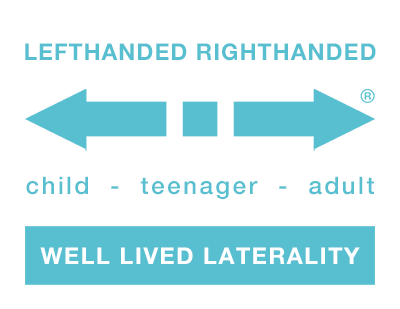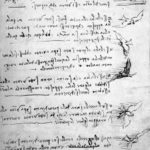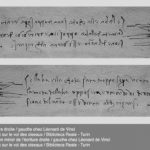books
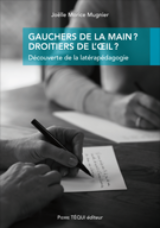
Distribution for North America of “Gauchers de la main ? Droitiers de l’oeil » Ed. P. Téqui – Saint Joseph Bookstore
Reading and writing are at the core of our lives.
Our laterality and the use we make of it impacts on our well-being.
It is important to properly diagnose your laterality to best approach it. The aim of laterapedagogy and lateratherapy is to try and reduce, or even remove incapacitating symptoms, optimizing your cognitive and conative (choice) abilities, recovering a physical and mental harmony and an emotional and psychological balance.
Revised edition, expanded with my latest research in laterality and the presentation of new clinical vignettes (title of the former edition: Gauchers en difficulté, la latérapédagogie, une richesse inexploitée).
This book is a testimonial and offers a method that enables you to restore your cognitive abilities and find a new personal balance.
In Leonardo da Vinci’s Footsteps - Da Vinci was a “true left-hander”
“In 1880, Karl Vogt, in his study Writing Physiologically Considered, attested that writing from right to left is indeed the natural way to write for left-handers. This observation is particularly referred to in Jules Crépieux-Jamin’s L’ABC de la graphologie (The ABC of graphology).
This was the case with Leonardo da Vinci, whose genius is legendary and who remains for us left-handers a master and a role model. As we know, Da Vinci was a “true left-hander”; 14 manuscripts were discovered in which he wrote entirely from right to left, amounting to thousands of pages…
But why did he copy whole sections from grammar, vocabulary and Latin conjugation books?”*
Leonardo da Vinci was not just anybody. Yet, there are many left-handers who write in their dominant opening direction, i.e. from right to left. They do so because it is more enjoyable for them but also because it soothes their brains. The majority are also left-eyed, so this allows them to visually follow what they are writing in their opening direction also. Thus they maintain their original brain function.
Today, more and more left-handers use tracing paper notebooks. It is a pleasure for them to have quality tools at their disposal, equivalent to those available to right-handers. Not only do they enjoy writing in this way, they can also be read by right-handers.
*Testimonial from Gauchers en difficulté – La latérapédagogie, une richesse inexploitée, published by Pierre Téqui, p.29: Joëlle Morice Mugnier suggests a few answers to questions emanating from Leonardo da Vinci’s genius.
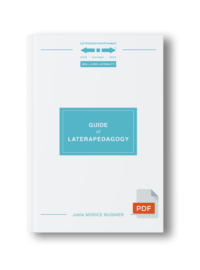
A guide for laterapedagogy in children, teenagers and adults to replace the old guide.
… MARCH / APRIL 2020 … !!!
Lock down…! » Ah yes! But I don’t like to read…!! «
https://youtu.be/IO5-dojVaF8
Of course!
Because it represents too much effort to concentrate and is hard to do for long.
That I have to read a sentence 3,4 or 5 times to understand them.
That I feel like I’m pushing words, rowing against the tide…
That it ends up triggering headaches, ophthalmic pain.
And the list goes on!
So maybe there’s a solution: Change your “audiovisual order.”
To change « audiovisual order » I propose to you:
1-
Give preference to magazine-type readings,
with column texts,
thus reduced width so the eye has less distance to travel.
2-
Place your book straight in front of you,
not leaning to an angle.
3-
Put the words in front of your right eye;
especially valid for the left page of a book.
4-
Orient your right eye as if it was a “laser”
and ask it nicely if it agrees to read in silence and in sequence;
the first word, then the second, and so on.
5-
Work the pivot (rotation) of your neck
to scan the text with your laser eye,
opening to the right
If you usually experience one of the symptoms mentioned
it is possible that your leading eye is the left eye.
And maybe your ear too.
It may not want to relinquish its place as leader
so easily to the right eye.
It will want to resist!
Speak to your eyes, negotiate with each one.
“Okay, my left eye, if you’re usually the leader,
then now you have the right to rest… and you, my right eye,
I know you don’t know this new job,
don’t worry, I’ll help you, I’ll teach you…”
6-
Repeat, step by step,
as if you wanted to strengthen your right eye.
7-
And little by little, since you are in “silent reading” mode,
check if the inner resonance of words is more intense
on the side of your right ear,
as if you asked your right eye to work hand-in-hand
with your right ear,
synchronized, so opening to the right à
with consistency.
Congratulations!
You are now activating your new “audiovisual order.”
Now train.
Boost your audiovisual order with flexibility.
Gradually switch from column texts to broader visual texts
for further adaptation and skill at reading with this new order.
On your computer, if possible,
juggle the width of the texts according to your need for comfort.
All this also applies when you write.
Finally, to read and write Hebrew and Arabic,
it is therefore necessary to make an inverted “audiovisual command”;
Binomial “left eye/left ear” opening towards the left
Feel, assess and observe:
maybe you will see your symptoms decrease
and you will discover new resources within yourself.
This is the sensation I wish for you to experience.
This is my advice, being a homogeneous
and unconstrained left-handed woman!
Joëlle Morice Mugnier.
If symptoms persist, please consult a Latepedagogue or Latérapraticien
Resources for teaching & therapy
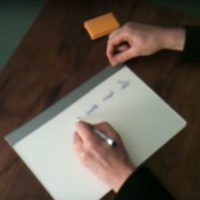
The double-sided whiteboard (L’ardoise double-sens®) is a registered trademark brand for what is commonly referred to as “mirror writing”, which is practiced by some left-handers and those with dyslexia. This educational tool is a patented invention, just like the tracing paper notebook using Canson brand paper.
It offers the same advantages as the tracing paper:
- Left-handers in Western cultures can write from right-to-left and then turn over the board for the writing to be read in the conventional left-to-right direction.
- Similarly, right-handers in Eastern cultures can write from left-to-right and then turn over the board for the writing to be read in the conventional right-to-left direction.
In Western cultures, the whiteboard also helps those with dyslexia:
- To see that when they write a “b” from left-to-right, it stays a “b” from right-to-left when they turn the board over. Same goes for “p”, “q”, “d”, and accent marks.
- To realize that having never before paid attention to their dominant right-to-left opening direction could be a contributing factor to their troubles. Indeed, many dyslexics are entirely left-handed (vision, hand, and foot), or right-handed for the hand, but left-handed for vision.
- To initiate rehabilitation of the person’s initial manual or visual laterality.
The double-sided whiteboard is currently in production and will be soon available to the public.
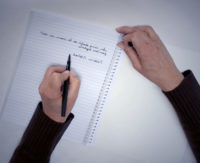
The tracing paper notebook is specially designed for left-handers who are more comfortable writing in their “opening” direction: right-to-left. Left-handers whose left eye is dominant will also naturally read what they write in the same direction.
Conveniently, this notebook allows their writing to be read by right-handers in their opening direction (left-to-right) simply by turning the page over.
Writing on a regular basis in one’s opening direction helps stimulate the right hemisphere of the brain (known for intellectual capacities), thus recreating “normal” neurological connections. This way, left-handers can enjoy real a sense of kinesthetic, as well as cognitive, mental and psychological comfort.
A tracing paper notebook designed for right-handers living in Eastern cultures is currently being produced. It will allow these right-handers to write in the dominant left-to-right opening sense with the right hand, and then turn over the page for their writing to be read in the conventional right-to-left direction.
Description :
- 96-page A4 size notebook
- Spiral binding is on the right side of the notebook to facilitate opening and writing from right-to-left with the left hand.
- A lined white cardboard divider is included to help write evenly and provide an opaque background to counteract the translucent effect of the tracing paper.
Cautionary note :
Use in any school-based context should be prefaced by discussion with teachers to explain the notebook’s educational and therapeutic value.
See the Testimonials for more information.
Avertissement : avant tout usage en milieu scolaire, il est vivement conseillé d’informer les enseignants de la portée pédagogiques et thérapeutique de cet outil. Cf. rubrique témoignages.
